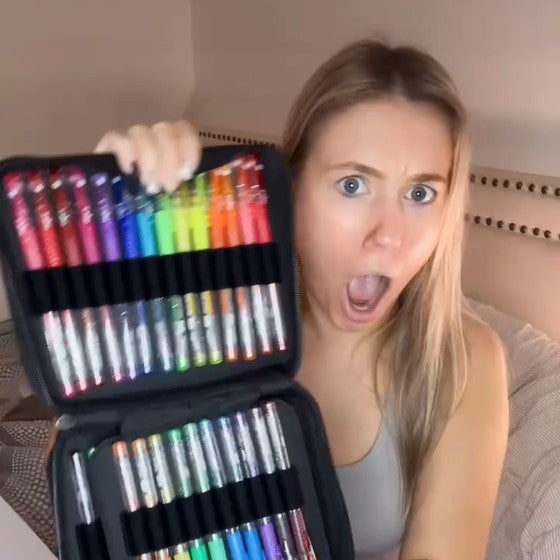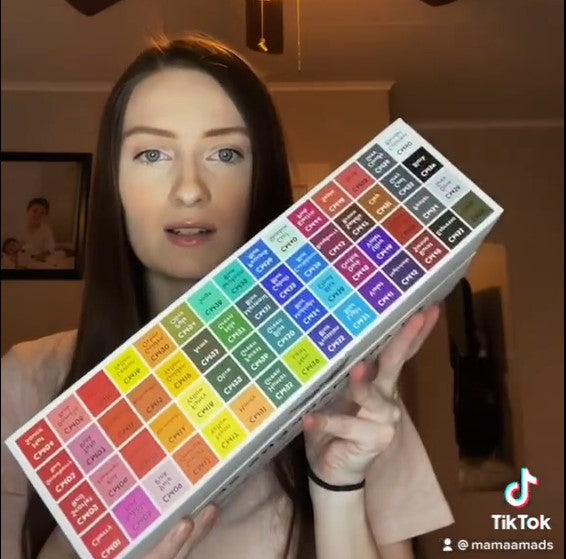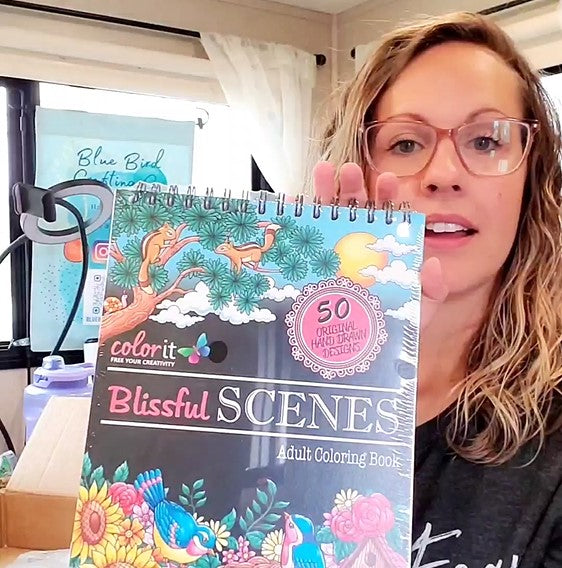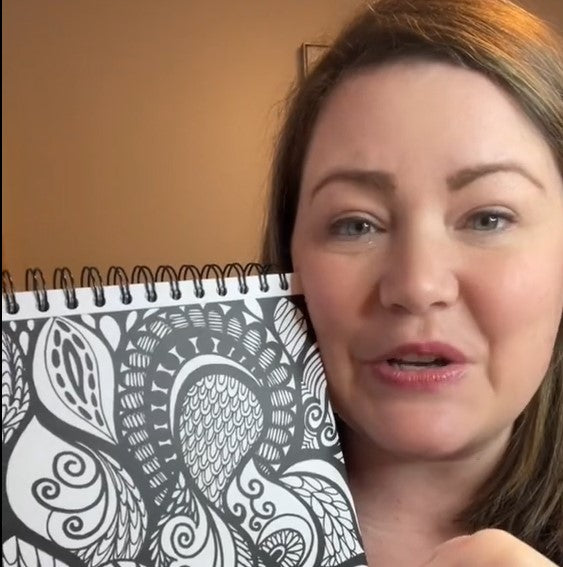Medical Research Points To Coloring Helping With Depression
Posted by Mia Pamisa on

Can Coloring Help With Depression?
“People think depression is sadness. People think depression is crying. People think depression is dressing in black. But people are wrong. Depression is the constant feeling of being numb. Being numb to emotions, being numb to life. You wake up in the morning just to go back to bed again.” ~ healthyplace.com
The Grey World of Depression
In a world that is by nature colorful, people suffering from depression live in one that’s grey most of the time. No matter what the weather or the season may be, when the blues hit, they just feel so low that they withdraw from the rest of the world until the fog lifts.
Most people suffering from depression take some time before they seek professional help, mainly because of the stigma attached to it. Also there is confusion in the symptoms that manifest. Some binge eat to feel better, while others lose their appetite when depressed. While others pour themselves into their work, and in contrast, someone going through the same mental disability would stay in bed, drapes drawn, and sleep in the dark for days.

“During this period of my life my self-confidence was at an all-time low, and I felt disgusted every time I looked in the mirror. I stayed away from people as much as I could, and felt I made an embarrassment of myself whenever I went out in public. I constantly had a voice in my head saying; why would anyone want to be friends with you? You are ugly and pathetic.”, recalls Bianca, a young professional working in sales, of her ordeal with depression.
According to her, her symptoms came out of nowhere. She just knew something was wrong when she started feeling constantly jittery, had panic attacks, and was throwing up in the mornings. She just didn’t know what it was, until a few years later when her world started to spiral out of her control. In the case of Bianca, her work in sales was a high pressure job and sick days were out of the question. The constant pressure gradually chipped at her feeling of balance and started to affect her emotionally.
Bianca’s story could be any one of the 16 million Americans diagnosed with depression every year. Contrary to what most people think, people suffering from depression don’t always look it, nor do they act morose all the time. Bianca’s friends and colleagues did not notice anything out of the ordinary, even though she was already mentally struggling with the demands of her everyday life. And it’s not surprising because people going through depression have a knack for hiding it very well, that even people they are in constant contact with wouldn’t notice. Some of them can even be described as colorful characters, the life of the party, but in reality, they’re already falling deep into depression on the inside.
The surprising things about depression
Studies show that symptoms for depression vary because stressors that trigger these symptoms vary. So, what can be a source of excitement or joy to one, could push another to anxiety or depression, which is what makes it not so easy to detect right away.
The thing with depression is that the interventions also vary, and what may work for one, may not work for others. Clinical treatments are usually administered in a combination of therapy and medication. There is no prescribed period for healing either. Hence, the healing process for persons going through it could have different durations. Surprisingly, despite the different causes, symptoms, and treatments, almost always persons going through depression engage in a coping technique that requires creativity - usually in music or art.
Positive Psychology
There is actually a science behind it. Mihaly Csikszentmihalyi, the Hungarian psychologist behind the concept of Flow, the psychology of optimal experience, also known as the Zone briefly explains it in a talk.
His curiosity was piqued when he observed that people who survived the second world war in Europe bounced back from the despair, moved on and were able to lead happy lives. Indeed it’s hard to imagine how people recover especially after seeing the horrors of the second world war.
He first noticed it in artists and was fascinated with how they got fully immersed in their craft to the extent of foregoing their need for food and sleep for days, just to find satisfaction in the completion of their craft. He suspected that there must be a correlation between happiness and creativity. The creative process seems to have a healing effect, although it is not the treatment itself.
Csikszentmihalyi and his fellow researchers conducted an extensive study on how a highly focused mental state can help people achieve a sense of well-being. His study suggested that people who engage in activities with intense focus and concentration, find satisfaction and a feeling of achievement as their work unfolds before them. The activity usually requires complete absorption without having to consciously process their thoughts into action. The effect is that it relaxes the mind even when preoccupied with an activity.
Why art? A study on The Connection Between Art, Healing, and Public Health which reviews current literature on the relationship between the creative arts and health outcomes show that the introduction of music or engagement in visual arts have an effect on the recovery of patients and the reduction of anxiety. The extent of its effect is still inconclusive. Thus, psychologists determine that although there is a positive effect towards recovery, it is considered as therapeutic and not treatment.
Visual arts therapy
It’s instinctive for people to heal themselves. Ever notice how, when we feel pain, we naturally take steps to stop the pain, to find relief from it? It’s as natural as breathing. The same thing happens to persons undergoing treatment for any illness, we instinctively do things that relieve us of pain or anxiety.
Music and visual arts have become very popular choices for these because of their therapeutic effect. And while psychologists have repeatedly emphasized that these activities do not constitute treatment, it has been observed that people going through depression find relief in visual arts therapy as it uplifts their mood and generates a sense of achievement.
What also contributes to its therapeutic effect are the colors and the repetitive patterns and motions of a creative art. This is why painting, needlework, and pottery are popular; the soothing motions and colors relaxes the mind and lifts the spirits.
Why coloring books can chase the blues away
The same principle applies to coloring adult coloring books, which has become immensely popular in recent years because of its therapeutic effect. Whether they are suffering from depression or not, people derive immense pleasure and satisfaction in the process and the result when they’ve completed coloring a drawing.

It has become popular particularly with adults, as they tend to concentrate more than kids would. For example they ensure that colors don’t get past the lines, or that the sequence of colors are followed in drawings with repetitive patterns.
Diane Cole, a school teacher shares how coloring has helped her overcome depression, “I do color to help ease my depression and anxiety.I found that art helps in many situations and was a great way to build trust and help students to become more sure of themselves and therefore better students. Even when reading books to the class it was helpful to often have them draw or color while relaxing and listening. So it's no wonder that coloring has become big for adults who live and work in a stressful world. It's so wonderful to relax and listen to music and just color without worrying about other things in our lives.”

This is the reason why the Mandala is very popular - the repetitive patterns are soothing to the senses. It relaxes the mind despite the focus and concentration required in following the sequence of colors in each pattern. This state is often described as “doing without doing” or a mindless concentration while doing something like mowing the lawn, knitting or coloring a drawing. Coloring books lets you free your creativity without overthinking the process.

Coloring books come in a variety of themes that match people’s interests. For example, cat and dog persons would be more likely be drawn to coloring books that feature animals, sewing hobbyists to home and hearth themes and so on. But what makes them therapeutic is not just the patterns but the colors that you use.
Natalie explains in this video how coloring has helped her cope with depression.
The Psychology of Colors
Studies have shown that colors can greatly influence the mood and emotions of people. Most of us are visual than auditory, hence, we use sight as the primary receptor of information around us. We get affected at the sight of blood because it connotes loss of life, among other things. Inversely, colors also trigger wonderful memories by associating colors to the colors present in a particular happy memory.
The brain is a tricky organ as it could make you think you’re forcing happiness into your existence, consequently taking you deeper into depression. Colors have meanings or relate to certain things. There’s a reason why blue and grey are often used by banks, or warm colors like orange and yellow in restaurants. These colors trigger an emotion in us, they can lift our moods, whet the appetite or impresses trust and a solid reputation as is with the use of blue and grey by banks. Colors influence our moods and emotions way more than we give them credit for.

Our subconscious does a lot of talking within us. We decide on mundane things every single day based on colors; from food, fashion, to the color of the office mug we drink our coffee from.
We know when a fruit can be eaten, made into jam, or be thrown away based on the color of its skin. We know winter is coming not because it is in Winterfell, but because the leaves have turned red and brown. We blush in embarrassment, turn green when we feel like barfing, or turn a grey pallor when dealt with terrible news.
Colors reflect and affect our moods and emotions. Just as a color can adversely affect our mood, we can also counter it by looking at colors that lift our spirits. So, if you need a pick up or just want to relax and unwind, try looking at colors that will help you get there. Here’s a simple guide on what colors mean...
The meaning of colors

Photo by Andrian Valeanu on Unsplash
RED is a color that’s everything but calm and composed. It invokes the strongest of emotions, from anger to passion and never associated with mediocrity or a lackadaisical existence. If it were a woman, red would walk in determined strides, give an impression of strong will, and sends a message of lust for life, love, and especially sex.
It’s the reason why you won’t see strong female characters in movies wearing pastel colors in power scenes, as that would be like dressing a king in pink tights. The color is too strong for it to take on a supporting role.
Tempering red is its mild cousin PINK. Pink is the representation of the things that matter. Whereas red is for passion or lust, pink stands for love and hope. It is the fine side and alter ego of red.

BLUE, although a strong color itself, is an antidote to Red. It is the color of trust and credibility. Notice how banks have blue in their brand symbol, interiors, office letterheads, and checkbooks? It represents a solid reputation, a strong foundation, reliability and credibility. It is almost as popular as black, and definitely a staple among power dressers in corporate America.
Blue lends elegance, superiority, as well as a sense of security. It is often associated with masculinity, power, and wealth. Blue is used in a lot of currencies, royal family emblems, flags, and other government symbols. It symbolizes tools of prosperity that it’s no wonder Fortune 500 companies are often referred to as blue chip companies.
Like red, blue has its own soft version in light or baby blue. It’s the color associated with male babies, just as pink is to female babies. Despite the pastel hue, light blue is associated with fair weather manifested in the clear blue skies or the warm waters of the sea.

Photo by Alexey Lin on Unsplash
YELLOW, is the color for the mind. It represents acquired knowledge, logic and creativity. It is a happy color, but one that is at the same time, curious, probing, and attracts a mental challenge. It is a color that can uplift the mood. Yellow stimulates enthusiasm, a vibe for life, and hope on good days. It encourages creativity.
If you need a good head on your shoulders in making a sound decision, yellow will help you get to it. It puts more weight on the mind than on the heart. Yellow relates to clarity of mind in situations that need resolution.
In contrast, yellow also relates to fast movement, and may drive anxiety in times when you’re not in a good place. It tends to make you critical of others as well as yourself. If there’s a color that thinks too much, yellow would be it. If you’re going through changes, yellow will agitate rather than calm and get you settled – but it will pass. Compliment yellow with green or a soft orange for balance.

ORANGE represents happiness, abundance, and spontaneity. It is a celebratory color, for it exudes expectations of a good harvest and health. It promotes good instincts, emotional strength, and recovery from grief.
If there is one color that has a heavy concentration of all the stuff that makes us feel good, it would be orange. It radiates cheerfulness, energy, optimism. It’s the happy cousin of yellow. A touch of orange, be it a plant, a picture frame or just a pen, will stimulate positivity to the mind. It helps build optimism when times are tough.
Orange represents adventure and YOLO moments that entail some risk, confidence and competition. It will keep you going when you are in despair and about to give up. It encourages people to reach out to other people and connect. It also whets the appetite, so if you don’t want to tip the scale, don’t have it in your kitchen.
On the overall, it’s a great color to have. Ironically, it’s not the color that’s been used extensively. The younger generations however love it.

Photo by Thomas Verbruggen on Unsplash
GREEN is a nurturing color. It promotes life, health, growth, and renewal. It’s the first color that emerges when winter is over and spring paves the way for summer. It is relaxing and relates to balance and harmony.
Green gives us the ability to love ourselves, to appreciate our environment, and see the blessings instead of difficulties. It is often used in symbols that promote good causes, because it promotes a sense of well-being, security, and a heartfelt desire to help others. If you love green, then your personality would reflect that you value and nurture relationships, be it for friends, family, colleagues or neighbors.
Green relates to wealth, prosperity and abundance. A word of caution though – green can also be materialistic and will evoke a strong feeling of possessiveness over people and things. There is vanity in green in the sense that it seeks recognition and appreciation. Just as it is loyal, it is also envious.
From the psychological perspective, green symbolizes stability and calmness. A great balance of the heart and the head is what it is. It will make you feel good but it will not lull you to a false sense of euphoria. It evokes feelings of generosity without having any tendency to be a martyr.
Loyalty is one of its strengths, which is why it is a friendly color. People who love green value relationships so much and usually can keep confidences. They will stick by friends, are persistent and consequently possess a strength to cope with challenges.

Photo by Bill Williams on Unsplash
If there is a color that relates to depth in terms of spirituality and conviction, it would be VIOLET. It is the combination of blue and red, both strong colors that are associated with heightened passion, anger, integrity and spirituality. A very obvious manifestation of this is the presence of violet in church and royal emblems. Formal and solemn ceremonies often have high priests and monarchs wearing violet in their clothes or jewels.
It represents future endeavors and like green, it promotes wealth. Violet generates an impression of nobility, luxury and extravagance. But wealth is not confined to material possessions, it also refers to wisdom and knowledge. Philosophers were given equal stature with the wealthy members of society, because of their wealth of knowledge. Today, one will find its affinity with knowledge in the emblems and symbols of educational institutions.
Intense is a word that best describes violet. Temper its use because it could influence one to go deep into depression. People in a vulnerable state should avoid it because it can aggravate feelings of despair or depression. Use it in small amounts to trigger your imagination, to encourage self-discovery, and channel it towards a positive outcome.
***
The mind is an unexplored world by itself. Psychologists still have a lot to learn about the human mind, its intricacies and the way it affects our overall well being. But while science tries to explain or find answers to mental issues such as depression and anxiety, art and music fill the gap in the meantime.
Indeed there is so much beauty in this world for us to see and appreciate. If at times we find ours to have turned grey or devoid of color, let your creativity fill it with color. Poet and writer Thomas Merton captures it aptly; “Art enables us to find ourselves and lose ourselves at the same time.”
***
Click here for more information about ColorIt coloring products.
OR
Share this post
- 3 comments
- Tags: coloring tips
3 comments








I’m physically disabled and suffer from PTSD. Some days my depression is so bad I can’t even get out of bed. Between the depression and my disabilities some days are hard to get through. I also get very bored which makes the depression worse. My doctor told my coloring can help and suggested I give it a try. I decided to purchase the coloring pencils, markets and pens. I can’t believe how nice the cases are they come with. I love them! Having them in the cases keeps them all in an organized way and they have their own cases. Having them organized like this keeps stress down! I’m so happy I made the purchase. I can’t tell you how happy I am with my purchase. Now that I’m coloring I have noticed it does help my depression. I get lost into the page I’m coloring and all the beautiful colors. I can spend a day off and on coloring and the day pass by so much quicker and less stressful. Now I even color with my grandchildren and it gives us time together. I’m limited in what I can do so having this new hobby to do together gives me and my grandchildren time together I would have missed!
Thank you ColorIt for bringing me and my grandchildren hours of fun and special time together! Thank you for the beautiful colors and the beautiful cases! I love it all so much and it’s the greatest purchase I have made this year!
Along with depression a lot of the time is anxiety. Coloring helps claim me every night before I go to bed. Getting a good night sleep keeps me out of deep depression. :)
This help my deprsssion and keep me from getting anxitey attacks too ot help me relax more..